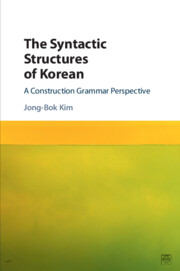Book contents
- Frontmatter
- Contents
- Acknowledgments
- Abbreviations
- 1 Theoretical foundations
- 2 Noun phrases
- 3 Case system
- 4 Auxiliary and complex predicate constructions
- 5 Gerund phrases and mixed categories
- 6 Verbal nouns and light verb constructions
- 7 Serial verb constructions
- 8 Negation and related phenomena
- 9 Coordination
- 10 Passive constructions
- 11 Wh-questions
- 12 Topic and focus constructions
- 13 Relative clause constructions
- 14 Honorification
- References
- Index
1 - Theoretical foundations
Published online by Cambridge University Press: 05 July 2016
- Frontmatter
- Contents
- Acknowledgments
- Abbreviations
- 1 Theoretical foundations
- 2 Noun phrases
- 3 Case system
- 4 Auxiliary and complex predicate constructions
- 5 Gerund phrases and mixed categories
- 6 Verbal nouns and light verb constructions
- 7 Serial verb constructions
- 8 Negation and related phenomena
- 9 Coordination
- 10 Passive constructions
- 11 Wh-questions
- 12 Topic and focus constructions
- 13 Relative clause constructions
- 14 Honorification
- References
- Index
Summary
This book, encompassing both empirical and theoretical issues of the Korean grammar, develops a constraint- and construction-based HPSG (Head-driven Phrase Structure) analysis. The constraint view assumes that grammar is a system of constraints governing the relation between form and meaning. This view eventually is combined with the philosophy of Construction Grammar in which functional knowledge of language is being based on an individual's systematic collection of “form and function pairings.” The book tries to merge these two perspectives of the grammar while seeking the greatest possible precision.
Derivational vs. constraint-based views
The central tasks of current linguistic theory are twofold. The first task is to explain how children are able to acquire grammatical competence even though they do not receive explicit instruction or have limited access to the data. This task is thus to account for the gap between children's knowledge of language and the apparent lack of substantive input for language, also known as Plato's problem. For example, assume that Korean speakers may hear both of the following Korean sentences including a relative clause:
(1) a. [_ppang-ul manhi sa-n] ai-ka wus-ess-ta
bread-ACC much buy-MOD child-NOM smile-PST-DECL
‘The child who bought a lot of bread smiled.’
b. [[_ppang-ul manhi sa-ss-ta-ko] Mimi-ka malha-n]
bread-ACC much buy-PST-DECL-COMP Mimi-NOM say-Mod
ai-ka wus-ess-ta
child-NOM smile-PST-DECL
‘The child who Mimi said bought a lot of bread smiled.’
From these two examples, speakers may infer that a subject from a matrix clause as well as from an embedded clause can be relativized. However, note that Korean speakers may not utter sentences like the following:
(2) *[[_ppang-ul manhi sa-n] kakey-lul] Mimi-ka malha-n
bread-ACC much buy-Mod store-ACC Mimi-NOM say-Mod
ai-ka wus-ess-ta
child-NOM smile-PST-DECL
‘(int.) The child who bought a lot of bread from the store which Mimi
mentioned smiled.’
Note that just like those in (1), the sentence in (2) also relativizes the subject of the embedded clause, but Korean speakers would not utter such a sentence. The question that follows is then how and why the language users, with no explicit instruction, can avoid generating such an unacceptable sentence.
The next and related task is to explain syntactic competence in language. Native speakers have the ability to combine structures to create simple as well as complex sentences.
- Type
- Chapter
- Information
- The Syntactic Structures of KoreanA Construction Grammar Perspective, pp. 1 - 25Publisher: Cambridge University PressPrint publication year: 2016

